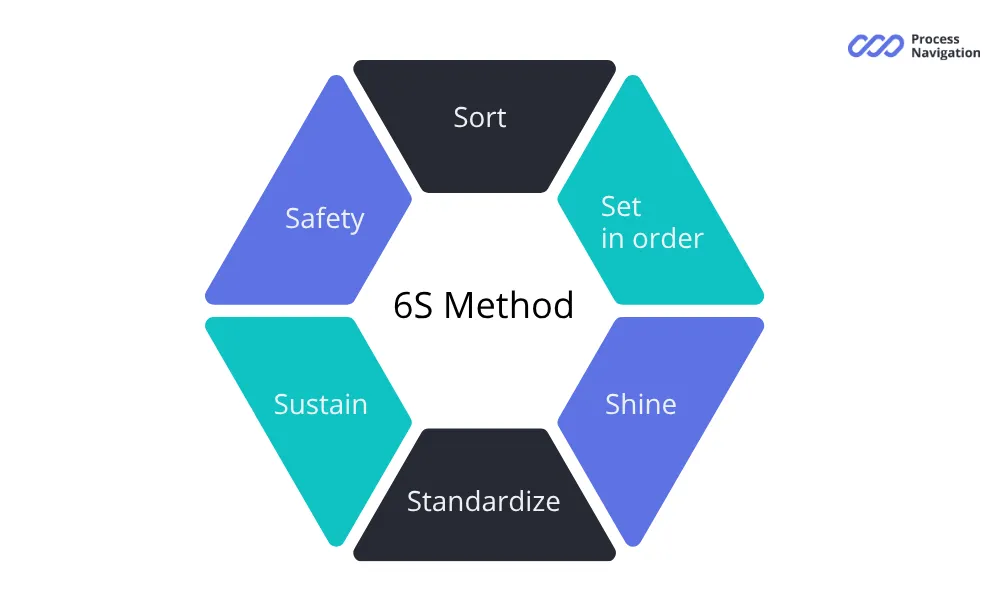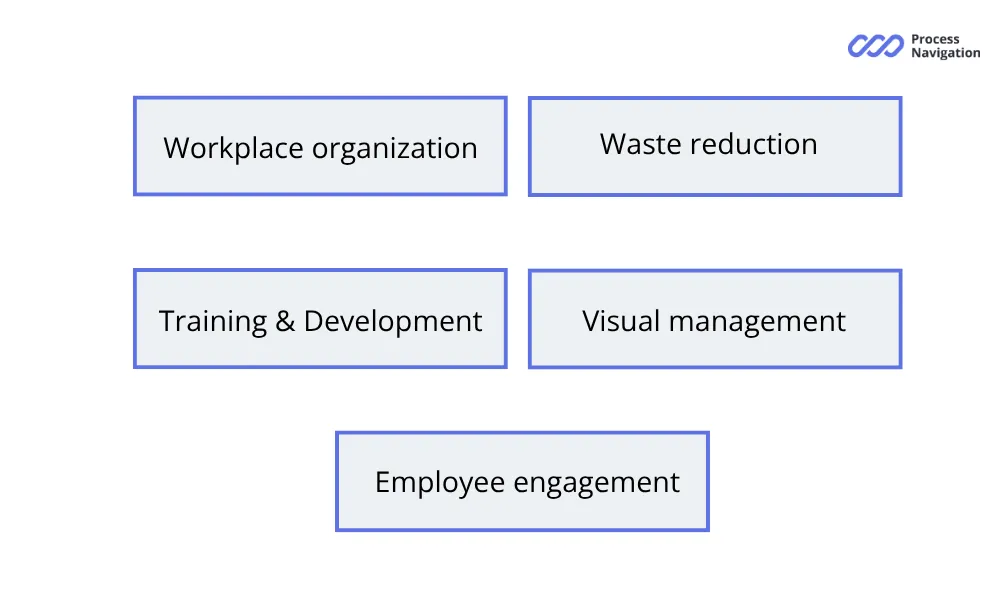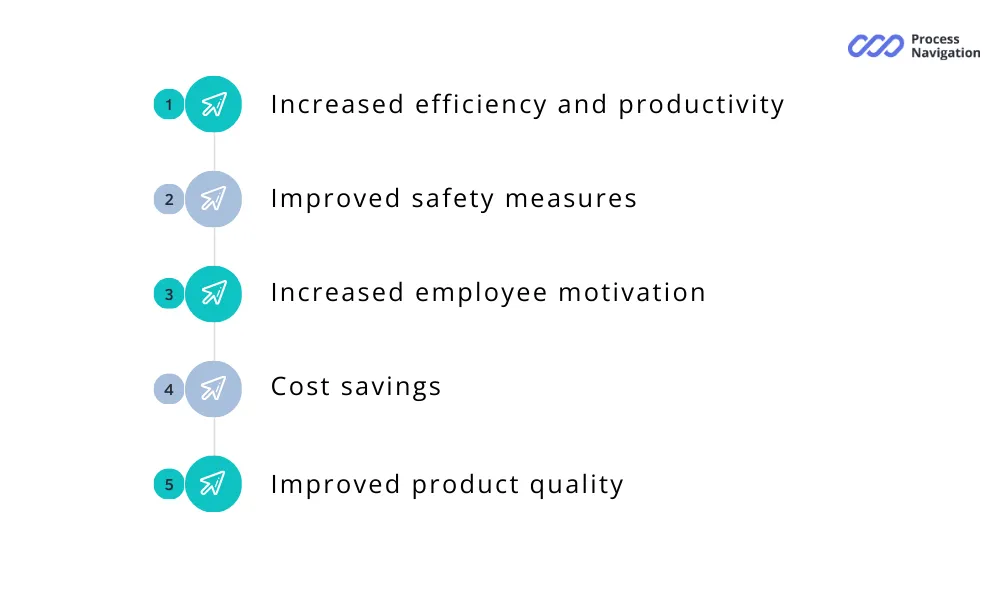No matter what kind of business you run — a factory, a warehouse, or an office — staying organized is essential for getting work done without delays, stress, or costly mistakes.When tools are easy to find, surfaces are clean, and everyone follows the same rules, work flows smoother and with fewer mistakes.
One of the most effective ways to set up this kind of environment is by using 6S. This method began as part of the Japanese Toyota Production System and quickly spread across industries around the world.
What is 6S Method
6S is a workplace organization system designed to improve efficiency, safety, and productivity through six structured steps: Sort, Set in Order, Shine, Standardize, Sustain, and Safety.
Originally developed from the 5S framework, 6S adds a critical focus on safety. This makes it especially effective in environments where both performance and employee well-being are essential — from factories and warehouses to modern offices.
Each step of 6S supports the others, helping businesses reduce waste, keep tools and materials in the right place, and maintain a clean, orderly space where teams can stay focused and work more effectively.
6S Definition

The 6S method (also called 5S+ Safety) is based on six sequential steps:
- Sort removes unnecessary items.
- Set in order ensures tools are logically positioned.
- Shine creates clean, comfortable working conditions.
- Standardize locks in the improvements and efficient work environment.
- Sustain maintains long-term adherence.
- Safety reduces workplace hazards.
| Sort (Seiri) | It is the process of clearing the workplace of extraneous items that are of no use in the task process. These can be personal stuff such as a phone, cosmetic bag, food, drinks, etc. or unnecessary tools. This step ensures only what’s needed is left, reduces distractions and minimizes hazard. |
| Set in Order (Seiton) | Workplace organization helps assign specific locations to tools and materials based on how frequently and in what order they are used, making them quick and easy to access. For example, there may be a designated area for handling products, including hazardous materials, and a separate space aimed at waste management. |
| Shine (Seiso) | Workplace cleanliness helps you spot defects and potential issues early so accidents don’t happen and processes run smoothly. A clean workspace without unnecessary items is not just about aesthetics — it directly contributes to an efficient workplace. |
| Standardize (Seiketsu) | This refers to creating uniform procedures across all areas. Simple methods, such as labeling and color coding, help everyone easily understand and comply with standards. It’s important to develop clear instructions to maintain consistency and ensure everyone follows the same procedures. |
| Sustain (Shitsuke) | Building a culture where following procedures becomes second nature. Regular ongoing training and audits reinforce these principles, making them permanent fixtures in the operational excellence framework. Quality audits also play a key role in sustaining 6S by regularly checking compliance and identifying areas for improvement. |
| Safety (Anzen) | Ensuring safety at every stage of work means identifying and eliminating hazards by conducting risk assessments, implementing safety measures, and creating a culture that cares about the health and safety of employees. |
6S Lean Principles
To fully understand what 6S is, we must recognize its core principles. They are based on lean management and help to reduce waste and improve performance.
To successfully implement 6S, it is important to follow these principles: workplace organization, waste reduction, employee engagement, visual management, training and development.

The 6S lean principles create an ecosystem where the physical layout, employee mindset, and management objectives are aligned. It helps support greater efficiency, fewer interruptions, and ultimately, workplace safety.
6S Advantages and Challenges
Modern businesses require clarity and operational efficiency. The 6S methodology assists in achieving this. Companies that have implemented it typically experience improved workplace efficiency and increased job satisfaction.
| Metric | Operational efficiency, average improvement |
| Reducing search time | 25-40% |
| Workflow efficiency | 15-30% |
| Equipment operating time | 10-25% |
In addition, using of 6S helps attain the following results:
- Increased Efficiency and Productivity. This is attained through process optimization. Employees do not have to make unnecessary movements searching for the right tools. All items are in their place, the workspace is properly zoned. All actions are standardized, so they are performed quickly and clearly. It allows to reduce a greater amount of work in a shorter period of time in an organized workplace.
- Improved Safety Measures. Safety is an integral part of the 6S system. Therefore, it includes measures that help create more comfortable working conditions by reducing possible risks. This is achieved by eliminating foreign objects. The equipment is handled carefully and serviced in a timely manner. Clear and understandable rules and safety protocols help reduce the number of workplace accidents, injuries, and occupational health hazards.
- Improved Product Quality. The implementation of the 6S system leads to improved product and service quality. Cleanliness helps prevent the risk that some garbage will get into the product during the production process. Standards and order create a clear step-by-step process that helps deliver the expected results, meet product requirements, and improve customer satisfaction.
- Cost Savings. Removing unnecessary things and simplifying processes reduces waste and makes better use of resources, which lowers costs. This means the company spends less money on materials. It also helps save time on tasks, making work faster and cheaper.
- Increased Employee Motivation. Some time after the system’s implementation, employees will fully appreciate its effectiveness. Working conditions will be more comfortable, which will increase the level of satisfaction and motivation of specialists. This leads to enhanced employee morale and encourages participation in continuous improvement.

While 6S offers lot of advantages, organizations may face implementation challenges:
- Initial Investment
6S requires upfront investment in training, reorganizing the workspace, and developing standardized procedures. This includes investments in personal protective equipment to ensure safe working conditions. - Change Management
Workers who are used to old methods may resist new approaches. Effective communication and employee involvement in the implementation process helps overcome resistance. - Resource Constraints
Implementing changes always requires money, time, and resources. Some companies may not have enough of these to fully implement 6S all at once. That’s why they need to do it step by step, using strategic action plans. - Sustaining Improvements
It can be hard to keep following 6S rules over time. Regular checks, continuous training, and support from management help make sure people stick to it.
6S in Manufacturing and Other Industries
Manufacturing processes are complex and involve multiple steps, equipment and personnel. Using 6S at each step in the work environment helps keep things running smoothly: materials are ready, tools are easy to find, and delays are few.
In factories and industrial plants, this method helps drive important changes in how things are organized. Steel mills, chemical plants, and food processing companies use it to fix many operational problems and improve their production.
Electronics companies using 6S lean improved efficiency by 30% and found over 50 potential hazards within their first three months. By training teams on these principles and applying them strictly, they turn disorder into order.
Textile manufacturers discover unique opportunities to apply the method for industry-specific challenges. The methodology proves particularly effective when handling different materials and meeting high standards for product quality.
Healthcare facilities use 6S to create sterile, highly organized environments in operating rooms, treatment areas, and pharmacy storage.
Financial institutions apply the methodology to optimize document flow and create customer-focused office spaces.
Educational institutions use 6S in labs, workshops, and offices to create better learning spaces.
Retail businesses adopt these principles to organize warehouses, optimize product displays, and improve customer service culture.
6S Implementation Strategy
But before anything else, companies need to ask themselves: what is 6S really about, and how does it fit our workflow?
Successful implementation of the system is a responsible step. To make this process effective, it is recommended to develop clear instructions and follow a certain sequence of actions.
- Notification and Training of Employees
This is a preparatory stage, during which management should notify employees about upcoming changes in order to help them prepare mentally. It is necessary to explain the need to implement a new lean management system in order to work out all possible objections. After that, it is worth training personnel in the basics and principles of the 6S system. - Analysis of the Current State of Workplaces
Specialists of each stages should audit their workflow to understand how it can be improved. This helps create comfortable working conditions in which the employee will be truly effective. Making changes without informing employees may lead to resistance. - Standardization and Systematization
Common industry standards can be a starting point, but it’s necessary to adapt them to the specific needs of the production process. This means adapting the procedures based on available resources and the product concept. The adopted standards should be documented to ensure they can be used for ongoing operations and employee training. - Maintaining Workplace Excellence
It’s important to know that this isn’t a one-time task but a continuous process. So, keeping things organized should be part of the employee’s regular duties. He is not a cleaner, but a organized work environment makes the execution of tasks a more efficient process. - Performance Monitoring
As the 6S system is implemented into work, it is necessary to monitor and evaluate the effectiveness of changes. Metrics include operation speed, defect reduction, and safety improvements. It’s important to encourage employees to propose improvements, contributing to greater organizational involvement.
FAQ
Begin by training staff on 6S lean principles, auditing current environments, identifying improvement areas, and setting measurable goals. Implementations often start with pilot areas before scaling.
By removing waste and distractions, standardizing operations, and addressing potential hazards, 6S naturally leads to increased efficiency and more focused workforces.
Absolutely! The 6S lean management is often used in manufacturing, but it also works well in offices. It helps organize digital files, clean up workspaces, and improve how tasks are done.
ProcessNavigation maximizes support for implementing and maintaining 5S and 6S methodologies by providing an integrated digital platform covering every stage of the process. The system enables organizations to create detailed workflow maps, track workplace conditions, and ensure continuous compliance with 6S standards. Key modules include: – Instructions, Checklists & Inspections — to standardize processes and ensure adherence to best practices. – Training — to accelerate onboarding and maintain skill levels. – Document Management — to keep critical information organized and accessible. – Incident Reporting — to quickly address and analyze workplace issues. – Task Management — to plan, assign, and track work efficiently. The platform continuously monitors compliance, automatically alerts management to deviations, and helps maintain order, safety, and discipline in daily operations.
-
 Maintenance Plan: What Is It And How Does It Work
Maintenance Plan: What Is It And How Does It WorkIn modern manufacturing, equipment downtime costs businesses thousands of dollars an hour. The difference between...
Technology
-
 Competency Management
Competency ManagementModern businesses face a big challenge: how do you ensure every employee has the skills...
Technology
-
 Unlocking the Benefits of Total Quality Management
Unlocking the Benefits of Total Quality ManagementIn today’s competitive world, the quality of products and services is becoming the key to...
Technology
